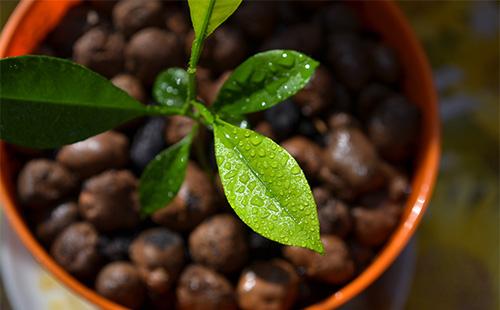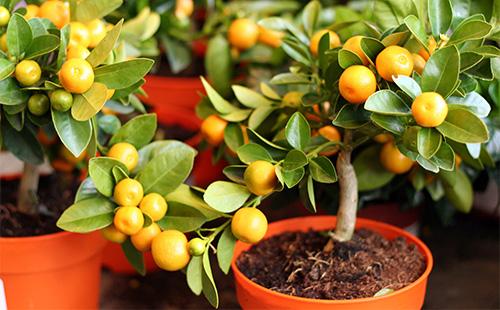The content of the article
You can grow indoor mandarin not only on the windowsill, but also in the greenhouse, on the balcony, in the conservatory. With proper care, it can even bear fruit. For home cultivation, breeders bred dwarf and stunted varieties up to 1-1.5 m high. Mandarin tree, unlike orange and lemon, is best adapted to the home microclimate.
"Domesticated" species
Not all varieties are suitable for indoor gardening. Mostly used undersized, since tall plants require constant pruning. Consider the most popular types and their distinctive features.
Table - Indoor types of tangerine tree and their features
| View | Features |
|---|---|
| Unshiu | - Fruits appear after 3-4 years in October-November; - the height can reach 1.5 m; - plentiful flowering in the spring; - fruits are pear-shaped, no seeds |
| Kowano Vasse | - Up to 80 cm high; - the fruits ripen in a year; - hard, massive branches; - fruits of bright orange color |
| Clementine (a hybrid of orange and mandarin) | - Fruits appear in the second year and have a flattened shape; - on the bush up to 50 pieces of fruit |
| Shiva Mikan | - early; - fruits weighing up to 30 g |
| Murcott | - A compact bush bears fruit in the summer; - sweet fruits |
Care for tangerine tree: what to consider
All plants love care and attention, and a tangerine tree is no exception. To make it not only beautiful and healthy, but also bear fruit, you should adhere to a few simple rules of detention.
Location and Lighting
Culture needs good lighting. A south, southwest, southeast window is best suited. In hot weather at lunchtime it is better to shade the plant. Otherwise, it will receive sunburn.
In the spring, the pot can be taken out to the balcony, the veranda and even to the street. Gradually we accustom the plant to ultraviolet, increasing the time spent in the air. Begin with partial shade, and then move on to sunny places.
Temperature
In order for the plant to bloom profusely, fruits are tied - in spring and summer, in the room we set the mode to 15-20 ° C. In winter, the ideal temperature is no more than 12-14 ° C. In such conditions, indoor culture will be able to relax and prepare for a period of active growth.
Humidity
In spring and summer, regularly wipe the leaves with a damp cloth or sponge. Throughout the year we carry out spraying from a spray gun. We use water at room temperature. In winter, when the heating is on, we carry out the procedures more often - several times a day. We irrigate in the early morning or late evening hours. The main thing is that direct sunlight should not fall on the moistened leaves.
Watering
Water for irrigation is heated to room temperature and defended. It is not recommended to use liquid from the tap, as it contains chlorine, salts and other substances that negatively affect the culture. To calculate the amount of water needed by the tree, we take into account the following factors:
- bush size;
- pot volume;
- room temperature;
- daylight and lighting quality.
It is especially important to properly care for the tangerine tree during flowering. From spring to autumn, “water” the plant abundantly and often. Water the tangerine tree should be with the complete drying of the soil. Checking this out is very easy. Take a handful of earth and squeeze it. If it has crumbled - it's time to go for a watering can. In winter, one approach of five to seven days is enough. Watering, as well as spraying, is carried out in the morning or in the evening.
Top dressing
The first meal after a winter holiday is better to add in April. Later, before the onset of cold weather, fertilizer is applied once every two weeks. This mode will allow the tree to bud, blossom and bear fruit. Regular summer recharge will help to avoid bitterness in the fruits. With the onset of cold weather, feeding is reduced or completely stopped.
Indoor decorative tangerine tree in a pot is strengthened with special mixes from the store intended for citrus fruits - organic or minerals. The older the bush, the more fertilizer it needs. We moisten the soil well before replenishment. Among folk remedies, cow slurry is used. But often it is available to gardeners living in rural areas.
Before using fertilizers, we carefully study the manufacturer's instructions. An incorrectly calculated dose can lead to damage to the root system.
Priming
The soil for young and adult plants should be different. In both cases, be sure to make a layer of drainage.
- For young plants. We mix one part of sheet land and sand and two parts of turfy earth. Add to the composition of humus from cow manure, if any.
- For adult bushes. We take for the soil one part of the sheet soil, three parts of the turf, one part of sand and humus. We also add a small amount of clay with a high percentage of fat.
Pinching and trimming
It is necessary to trim and pinch a tangerine tree. Thanks to the procedure, a neat and beautiful crown will be formed, the fruits will appear faster. Weakened and unnecessary branches in terms of aesthetics are removed. You can get a dense crown if you carefully pinch the shoots from the top of the bush.
Young plants during the first flowering period require a special approach. Part of the buds is best removed to preserve the vitality of the bush. If this is not done, then in the future the plant will yield few fruits. In addition, the smaller the flowers, the larger the fruits.
Transfer
Young bushes are better off changing the pot every year. The root system is constantly evolving, so it needs more free space. If the roots have not braided the soil lump, then leave the plant alone. But in this case, we replace the upper soil layer and drainage.
The features of caring for a tangerine tree with fruits are a transplant to a new place every two to three years. Bushes over the age of five to six do not need to change capacity.
Reproduction: 2 ways
The plant can be propagated with the help of seeds, cuttings and supplemented by inoculation. The method in most cases is selected taking into account the age of the bush.
Seeds
Features. It is not difficult to grow a tangerine tree from seed, but you will have to wait 10-15 years for flowering and fruits, and you can not wait at all. Fruiting can be accelerated by planting a branch from an adult fruiting bush on young tangerine. The sapling to which a twig is grafted is called a stock. And the stem from the fruiting plant is a graft.
Action algorithm
- The easiest option is to plant the seeds immediately in moist soil without prior preparation. Or we put the seeds in gauze, moisten it with water or a weak solution of potassium permanganate. Instead of gauze, you can use a hydrogel that holds moisture well. Put it on a plate and mix with seeds.
- We put gauze or hydrogel with seeds in the soil.
- After the appearance of the first leaf, we transplanted by transshipment (without destroying the earthen lump with roots) into the flowerpot.
- We grow from one to three years. The bush will be ready for grafting when the trunk diameter reaches a minimum of 6 mm. Then we proceed to the vaccination procedure. The optimal period is from April to May.
- As a scion, cut a twig of one or two years old from a healthy, fruiting bush. We remove leaf plates, spikes from the handle.
- We make an incision in the rootstock in the form of the letter "T". Here we insert the stalk.
- Wrap the place of vaccination with electrical tape. Create a greenhouse effect with a plastic bag or plastic container.
- After about 21 days, shoots should appear from the kidneys. Gradually accustom them to the microclimate of the room - remove the polyethylene or plastic container. We remove the fixing bandage.
- We cut off at a slant that part of the rootstock stem that remains above the grafted graft. We process the site with coal.
- We tie the young plant to the stick so that it grows vertically. If the vaccination is successful, the new plant will please flowering throughout the year.
Cuttings
Features. The method is more popular, since a plant grown from the cuttings of an adult bush will bloom and yield fruits in a year, a maximum of two.
Action algorithm
- Cut the stalk and place it in a container of water.
- We create a greenhouse effect - we cover the stalk with a plastic bag or a bottle of plastic. It can take two to three months to root.
- We transplant into a pot when the roots appear.
Pests
Citrus tree, like other indoor crops, is susceptible to attack by insects. In the fight against them, we use both folk remedies and store products.
Red spider mite
Dots of red color appear on the stems. With severe damage, pests are visible that form an almost imperceptible web. Appear in a dry, hot microclimate. We fight with the help of two folk remedies.
- Tobacco dust. Dissolve one tablespoon of dust in boiled water and insist for six hours. Add 10 g of soap to the mixture. Treatment: spray the bush three times every six to seven days.
- Garlic. Chive a garlic in a glass of boiled water for two days. We carry out the procedure, as with tobacco dust.

Mealybug
Sticky white spots appear on the leaves. On the roots, it is much more difficult to notice. The main symptom is that the foliage dries and falls. The most effective tool is a soap solution. Spray once every six to seven days. The procedure should consist of three approaches.
Shield
A sign of the appearance of a scale insect is a dried bush with yellowed leaves. Brown outgrowths form. The main reason is dry, unventilated air. We use two methods of treatment.
- Mechanical cleaning. With a toothbrush or gauze we independently remove insects. We wash the place where the pot stands with a solution of soap.
- Solution spraying. Mix one teaspoon of machine oil, two tablespoons of washing powder, a little chopped laundry soap with a glass of water. The solution is sprayed with leaves, branches. After four hours, rinse with water. The procedure is repeated at least three times a month.

Problems
In addition to pests, the plant is susceptible to diseases associated with improper care. Four common symptoms can be noted.
- Rusty spots. The reason is improper watering. Adjust the moisture supply.
- Shriveled leaves. The blame is a large amount of ultraviolet radiation. Shade the bush.
- Small and drying bushes. The reason is the lack of fertilizer. We bring in minerals and vitamins.
- Tangerine leaves fall. If this is an adult plant, then you should not worry, as this is a sign of "old age". In young bushes, the leaves turn yellow and fall off due to an excess of light, lack of nitrogen.
Knowing how to care for a tangerine tree, you can grow a solar plant on the windowsill, the fruits of which have a lot of useful properties. It is known that the fruit has phytoncidal properties that inhibit the activity of microbes, and is able to alleviate the condition with dysentery or diarrhea. Fresh juice is even able to destroy some types of fungi with skin diseases.

